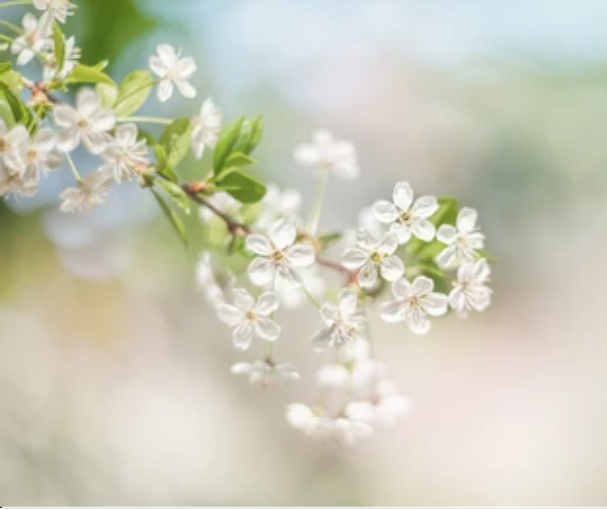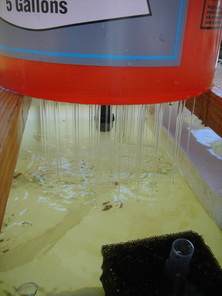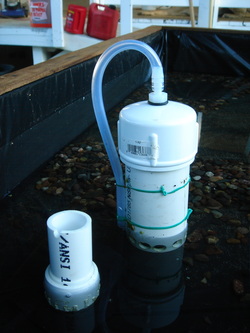What is Aquaponics? Aquaponics is an integrated aquaculture (growing fish) and hydroponic (growing soil-less plants) system that mutually benefits both environments. Aquaponics uses no chemicals, requires one tenth or 10% of the water needed for field plant production and only a fraction of the water that is used for fish culture (Aquaculture).
Aquaponics is the symbiotic cultivation of plants and aquatic animals in a recirculating environment. Aquatic animal effluent -fish waste- accumulates in water as a by-product of keeping them in a closed system or tank. The effluent-rich water becomes high in plant nutrients but this is correspondingly toxic to the aquatic animal. Plants are grown in a way that enables them to utilize the nutrient-rich water. The plants take up the nutrients, reducing or eliminating the water's toxicity for the aquatic animal. The water, now clean, is returned to the aquatic animal environment and the cycle continues. Aquaponic systems do not discharge or exchange water. The systems rely on the relationship between the aquatic animals and the plants to maintain the environment. Water is only added to replace water loss from absorption by the plants, evaporation into the air, or the removal of biomass from the system.
The waste from fish tanks is used up by natural bacteria that converts the waste, largely ammonia, first to nitrite and then to nitrate. The fish waste water is pumped to a bio-filter system for break-down, and then used as a nutrient solution for the growing plants. The only external input to the system is food for the fish. Both systems complement each other as a single unit.
Once the system is initialized the water stays pH balanced and remains crystal clear. The water is recycled with a small amount of water added weekly to compensate for what is lost by evaporation and transpiration by the plants. Aquaponics is the future of sustainable home gardening and commercial fresh food production.
Greenhouse growers and farmers are taking note of Aquaponics for several reasons:
* Hydroponic growers view fish-manured irrigation water as a source of organic fertilizer that enables plants to grow extremely well, in some cases better than soil!
* Fish farmers view hydroponics as a bio-filtration method to facilitate intensive re-circulating aquaculture, with no "pour-off" or waste water.
* Greenhouse growers view Aquaponics as a way to introduce organic hydroponic produce into the marketplace, since the only fertility input is fish feed and all of the nutrients pass through a natural biological process.
* Food-producing greenhouses – yielding two products (plants & fish) from one production unit – is naturally appealing for self-sustainability and green labeling.
* Aquaponics can enable the production of fresh vegetables and fish protein in arid regions and on water-limited farms, since it is a “water re-use” system, with no by-products, pour-off, or waste water.
* Aquaponics is a working model of sustainable food production wherein plant and animal agriculture are integrated and recycling of nutrients and water filtration are linked.
Plants Adapted to Aquaponics: The selection of plant species adapted to hydroponic culture in Aquaponic greenhouses are related to stocking density of fish tanks and subsequent nutrient concentration of Aqua-cultural effluent. Lettuce, herbs, and specialty greens (spinach, chives, basil, and watercress) have low to medium nutritional requirements and are well adapted to Aquaponic systems. Plants yielding fruit (tomatoes, bell peppers, and cucumbers) have a higher nutritional demand and perform better in a heavily stocked, well established Aquaponic system.
Fish Species: Several warm-water and cold-water fish species are adapted to re-circulating aquaculture systems, including tilapia, trout, perch, Arctic char, and bass. However, most commercial Aquaponic systems in North America are based on tilapia. Tilapia is a warm-water species that grows well in a re-circulating tank culture. Furthermore, tilapia is tolerant of fluctuating water conditions such as pH, temperature, oxygen, and dissolved solids. Tilapia produces a high quality white-fleshed meat suitable to local and wholesale markets. The fish has a delicate clean flavor and should not taste muddy- if it does that means it came from very low quality and dirty waters. Barramundi and Murray cod fish species are commonly raised in re-circulating Aquaponic systems in Australia.
Water Quality Characteristics: Fish raised in re-circulating tank culture require good water quality conditions. Water quality testing kits are fundamental. Critical water quality parameters include dissolved oxygen, carbon dioxide, ammonia, nitrate, nitrite, pH, chlorine, and other characteristics. The stocking density of fish, growth rate of fish, feeding rate and volume, and related environmental fluctuations can elicit rapid changes in water quality; constant and vigilant water quality monitoring is essential.
Bio-filtration and Suspended Solids: Aquaculture effluent contains nutrients, dissolved solids, and waste byproducts. Some Aquaponics systems are designed with intermediate filters and cartridges to collect suspended solids in fish effluent, and to facilitate conversion of ammonia and other waste products to forms more available to plants prior to delivery to hydroponic vegetable beds. Other systems deliver fish effluent directly to gravel-cultured hydroponic vegetable beds. The gravel functions as a “fluidized bed bioreactor,” removing dissolved solids and providing habitat for nitrifying bacteria involved in nutrient conversions.
We are very excited as we are currently upgrading and expanding, and will have fish available soon! The fish we will be stocking is hormone-free and is called the Nile Tilapia (Oreochromis mossambicus). They are an omnivorian fish and will thrive being fed all natural organic plant foods like duckweed.
Aquaponics is the symbiotic cultivation of plants and aquatic animals in a recirculating environment. Aquatic animal effluent -fish waste- accumulates in water as a by-product of keeping them in a closed system or tank. The effluent-rich water becomes high in plant nutrients but this is correspondingly toxic to the aquatic animal. Plants are grown in a way that enables them to utilize the nutrient-rich water. The plants take up the nutrients, reducing or eliminating the water's toxicity for the aquatic animal. The water, now clean, is returned to the aquatic animal environment and the cycle continues. Aquaponic systems do not discharge or exchange water. The systems rely on the relationship between the aquatic animals and the plants to maintain the environment. Water is only added to replace water loss from absorption by the plants, evaporation into the air, or the removal of biomass from the system.
The waste from fish tanks is used up by natural bacteria that converts the waste, largely ammonia, first to nitrite and then to nitrate. The fish waste water is pumped to a bio-filter system for break-down, and then used as a nutrient solution for the growing plants. The only external input to the system is food for the fish. Both systems complement each other as a single unit.
Once the system is initialized the water stays pH balanced and remains crystal clear. The water is recycled with a small amount of water added weekly to compensate for what is lost by evaporation and transpiration by the plants. Aquaponics is the future of sustainable home gardening and commercial fresh food production.
Greenhouse growers and farmers are taking note of Aquaponics for several reasons:
* Hydroponic growers view fish-manured irrigation water as a source of organic fertilizer that enables plants to grow extremely well, in some cases better than soil!
* Fish farmers view hydroponics as a bio-filtration method to facilitate intensive re-circulating aquaculture, with no "pour-off" or waste water.
* Greenhouse growers view Aquaponics as a way to introduce organic hydroponic produce into the marketplace, since the only fertility input is fish feed and all of the nutrients pass through a natural biological process.
* Food-producing greenhouses – yielding two products (plants & fish) from one production unit – is naturally appealing for self-sustainability and green labeling.
* Aquaponics can enable the production of fresh vegetables and fish protein in arid regions and on water-limited farms, since it is a “water re-use” system, with no by-products, pour-off, or waste water.
* Aquaponics is a working model of sustainable food production wherein plant and animal agriculture are integrated and recycling of nutrients and water filtration are linked.
Plants Adapted to Aquaponics: The selection of plant species adapted to hydroponic culture in Aquaponic greenhouses are related to stocking density of fish tanks and subsequent nutrient concentration of Aqua-cultural effluent. Lettuce, herbs, and specialty greens (spinach, chives, basil, and watercress) have low to medium nutritional requirements and are well adapted to Aquaponic systems. Plants yielding fruit (tomatoes, bell peppers, and cucumbers) have a higher nutritional demand and perform better in a heavily stocked, well established Aquaponic system.
Fish Species: Several warm-water and cold-water fish species are adapted to re-circulating aquaculture systems, including tilapia, trout, perch, Arctic char, and bass. However, most commercial Aquaponic systems in North America are based on tilapia. Tilapia is a warm-water species that grows well in a re-circulating tank culture. Furthermore, tilapia is tolerant of fluctuating water conditions such as pH, temperature, oxygen, and dissolved solids. Tilapia produces a high quality white-fleshed meat suitable to local and wholesale markets. The fish has a delicate clean flavor and should not taste muddy- if it does that means it came from very low quality and dirty waters. Barramundi and Murray cod fish species are commonly raised in re-circulating Aquaponic systems in Australia.
Water Quality Characteristics: Fish raised in re-circulating tank culture require good water quality conditions. Water quality testing kits are fundamental. Critical water quality parameters include dissolved oxygen, carbon dioxide, ammonia, nitrate, nitrite, pH, chlorine, and other characteristics. The stocking density of fish, growth rate of fish, feeding rate and volume, and related environmental fluctuations can elicit rapid changes in water quality; constant and vigilant water quality monitoring is essential.
Bio-filtration and Suspended Solids: Aquaculture effluent contains nutrients, dissolved solids, and waste byproducts. Some Aquaponics systems are designed with intermediate filters and cartridges to collect suspended solids in fish effluent, and to facilitate conversion of ammonia and other waste products to forms more available to plants prior to delivery to hydroponic vegetable beds. Other systems deliver fish effluent directly to gravel-cultured hydroponic vegetable beds. The gravel functions as a “fluidized bed bioreactor,” removing dissolved solids and providing habitat for nitrifying bacteria involved in nutrient conversions.
We are very excited as we are currently upgrading and expanding, and will have fish available soon! The fish we will be stocking is hormone-free and is called the Nile Tilapia (Oreochromis mossambicus). They are an omnivorian fish and will thrive being fed all natural organic plant foods like duckweed.
Here is a breakdown and a little more info on our personal Aquaponics system. It has currently been running for 3 years now with one cycle of Tilapia as our harvest fish. This chronicles our first year:
The Complete System
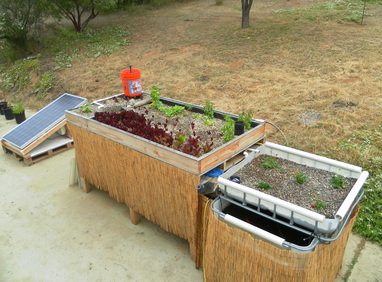
Our Aquaponics system in it's entirety;
Fish tote, grow bed #1, grow bed #2, biofilter, water pump, fish tank heater and 2 bell syphons. Our system is currently being run off a single 180 watt solar panel coupled with a 5000 watt inverter and 4 deep cycle rechargeable batteries.
Fish tote, grow bed #1, grow bed #2, biofilter, water pump, fish tank heater and 2 bell syphons. Our system is currently being run off a single 180 watt solar panel coupled with a 5000 watt inverter and 4 deep cycle rechargeable batteries.
Step 1
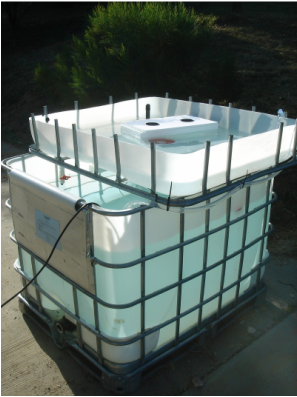
We obtained a tote to be used as our fish tank, cleaned it out exceptionally well and cut off the top 1/5 of the tote and flipped it upside-down to create the first grow-bed. Smaller Aquaponics systems can run with just this one grow-bed if desired.
We also added our "starter fish" at this time. When you first start an aquaponic system you need to put in starter fish to get the nitrogen cycle going. These fish need to be some of the toughest fish in the neighborhood because they will have to put up with a whole variety of unpleasantness as the water settles into its natural cycle. Until the natural friendly bacteria starts up there will be peaks in both Ammonia and Nitrites and it is essential that the starter fish that you select are able to tolerate this. We selected large "feeder" goldfish from the pet store, as they grow quickly, don't require heat, are very hardy to water fluctuations, and lastly, are very inexpensive.
These fish are doing a valuable job for you so make sure that you look after them while the tank is starting up; don't forget to feed them and don't let water conditions get too extreme. Keep an eye on the ammonia and nitrite levels and be prepared to do a partial water change whenever needed.
We use a "Master Test Kit" (made for aquariums) to check the nitrates, nitrites, pH, and ammonia levels weekly. A pet store sales associate should be able to tell you how to use one to take readings. Our tank hold roughly 250 gallons and we started with only about 30 starter fish, so there weren't very many "swings" in the above mentioned nutrients during the cycling period.
*NOTE: DO NOT add your "harvest/ stock fish" until the tank has been completely cycled. This should take about 1-2 months.
The starter fish can either be removed, used as a food source for the new fish, or left in the fish tote to live along side your future harvest fish.
We also added our "starter fish" at this time. When you first start an aquaponic system you need to put in starter fish to get the nitrogen cycle going. These fish need to be some of the toughest fish in the neighborhood because they will have to put up with a whole variety of unpleasantness as the water settles into its natural cycle. Until the natural friendly bacteria starts up there will be peaks in both Ammonia and Nitrites and it is essential that the starter fish that you select are able to tolerate this. We selected large "feeder" goldfish from the pet store, as they grow quickly, don't require heat, are very hardy to water fluctuations, and lastly, are very inexpensive.
These fish are doing a valuable job for you so make sure that you look after them while the tank is starting up; don't forget to feed them and don't let water conditions get too extreme. Keep an eye on the ammonia and nitrite levels and be prepared to do a partial water change whenever needed.
We use a "Master Test Kit" (made for aquariums) to check the nitrates, nitrites, pH, and ammonia levels weekly. A pet store sales associate should be able to tell you how to use one to take readings. Our tank hold roughly 250 gallons and we started with only about 30 starter fish, so there weren't very many "swings" in the above mentioned nutrients during the cycling period.
*NOTE: DO NOT add your "harvest/ stock fish" until the tank has been completely cycled. This should take about 1-2 months.
The starter fish can either be removed, used as a food source for the new fish, or left in the fish tote to live along side your future harvest fish.
Closer Look at Grow Bed #1

We first started our system with individual plugs grown right in water, (called deep water culture), planted in a hydroton medium, in net cups which are suspended in foam. In the beginning the water never drained completely empty, but rather, was at a constant flow, keeping the oxygen and nutrients available for the plants.
Step 2
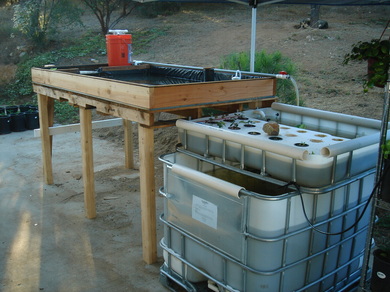
We built second grow bed. Installed pump and all pipes, biofilter and bell syphons.
Step 3
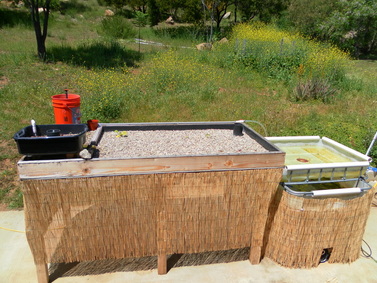
After trying the deep water culture for a couple months while the system was cycling, we decided we wanted to switch the system to an "Ebb and Flow" system where the plants are put directly into a planting medium, and the water filled and drained (instead of consistent flowing). So we "filled in" the water basins with gravel. The system was easier to keep free of algae when designed like this.
We also took our indoor started plants and got them ready to plant!
Lastly, we added the bamboo skirt to create a storage area underneath.
We also took our indoor started plants and got them ready to plant!
Lastly, we added the bamboo skirt to create a storage area underneath.
Step 4

We planted all of our starter plants. Mostly lettuce and some spinach, but we also planted a couple varieties of basil, squash and tomatoes.
We planted the plants first to make sure there was enough filtration for the upcoming harvest fish. But by the time the plants were big enough to have a higher nutrient requirement the fish were large enough to provide it!
We planted the plants first to make sure there was enough filtration for the upcoming harvest fish. But by the time the plants were big enough to have a higher nutrient requirement the fish were large enough to provide it!
Step 5
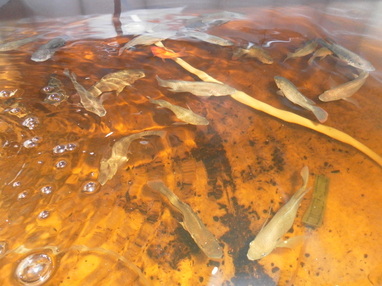
The exciting day we added our "Harvest Fish"! We chose tilapia as they are easy to care for and generally reach a harvestable size in about 9 months.
In this picture they are approx 6 months old. We bought them as tiny fingerlings and kept them inside in an aquarium for about two months until the aquaponics tote was ready for them. Unfortunately we had heavy losses in the first year experimenting with Tilapia. We started with 75 fingerlings, but lost more than half to an aquarium disease unknowingly brought home from a pet store. We ended up adding about 35 to the tote.
We planned it out so that the fish were put into the system in early spring, so they had more opportunity to grow, better weather (warmth), and also to fertilize the tote for our upcoming spring plants.
In this picture they are approx 6 months old. We bought them as tiny fingerlings and kept them inside in an aquarium for about two months until the aquaponics tote was ready for them. Unfortunately we had heavy losses in the first year experimenting with Tilapia. We started with 75 fingerlings, but lost more than half to an aquarium disease unknowingly brought home from a pet store. We ended up adding about 35 to the tote.
We planned it out so that the fish were put into the system in early spring, so they had more opportunity to grow, better weather (warmth), and also to fertilize the tote for our upcoming spring plants.
Step 6
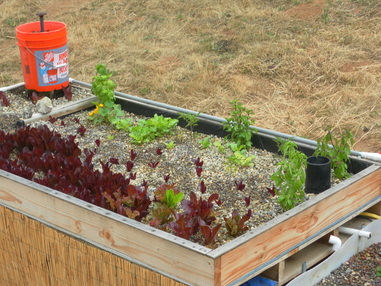
Watch your plants grow and harvest as needed!

Lettuce grows really fast! We harvest by snipping off the outside leaves as needed. There is nothing better than fresh home-grown butter and flame lettuces!

Large plants! They grow VERY quickly in an aquaponics system. We had more than enough lettuce for eating, more than enough basil for pesto, and plenty of tomatoes for salsa!

By summer the lettuce was ready to be harvested and cut down. We did let some bolt so we could collect seeds. We always buy heirloom plants and save seeds.
At this time the basil and tomatoes are still going strong.
At this time the basil and tomatoes are still going strong.
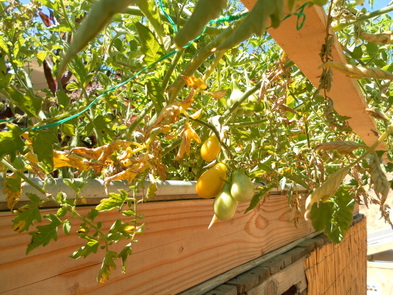
We got a ton of tomatoes from three tomato plants. We chose a smaller variety, yellow pear, and they did exceptionally well, but grew almost too big for the grow bed!
* Tomatoes are generally not recommended for aquaponics systems unless it is well established and nutrient heavy (lots of fish).
* Tomatoes are generally not recommended for aquaponics systems unless it is well established and nutrient heavy (lots of fish).

By the end of summer everything had bolted. We collected seeds, had one final harvest and then tore the plants out, cleaned it up and got it ready for next spring!
Since it was our first year and we were still experimenting and learning, we unfortunately had a loss with our fish as we let them live into winter and lost them due to the cold. Tilapia need water over 55*F to survive. Right about 55* degrees ours got very lethargic and the next cold night they died. We did utilize an aquarium heater, but it was not strong enough to heat the large tote, and a larger wattage heater would have drained the solar system before the nights end, so we were stuck with no option to quickly fix it.
We are now working on building a hoop house (mini-greenhouse) so we can grow plants and fish year round!
Since it was our first year and we were still experimenting and learning, we unfortunately had a loss with our fish as we let them live into winter and lost them due to the cold. Tilapia need water over 55*F to survive. Right about 55* degrees ours got very lethargic and the next cold night they died. We did utilize an aquarium heater, but it was not strong enough to heat the large tote, and a larger wattage heater would have drained the solar system before the nights end, so we were stuck with no option to quickly fix it.
We are now working on building a hoop house (mini-greenhouse) so we can grow plants and fish year round!

